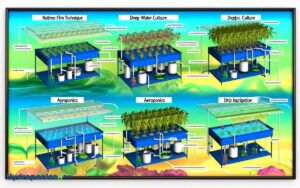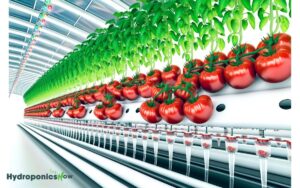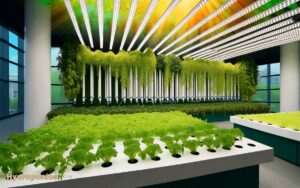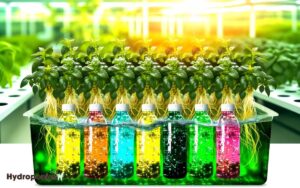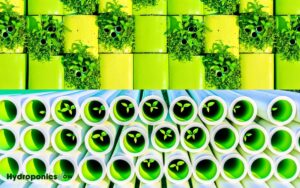Types of Commercial Hydroponic Systems: Exploring Options!
Commercial hydroponic systems encompass several advanced methodologies for ideal plant growth.
- Deep Water Culture submerges roots in oxygenated water, facilitating rapid growth.
- The Nutrient Film Technique uses a nutrient-rich water film for maximum uptake.
- Ebb and Flow floods plant roots periodically, ensuring ideal nutrient delivery.
- Aeroponics enhances growth by misting roots with nutrient solutions.
- Drip Systems provide controlled nutrient flow to each plant.
Innovations like Vertical Hydroponics maximize space and yield. Integrative systems – Aquaponics and Fogponics – enhance nutrient efficiency and sustainability.
Hybrid systems offer customizable, high-yield solutions. Understanding these techniques deeply can revolutionize modern agriculture systems.
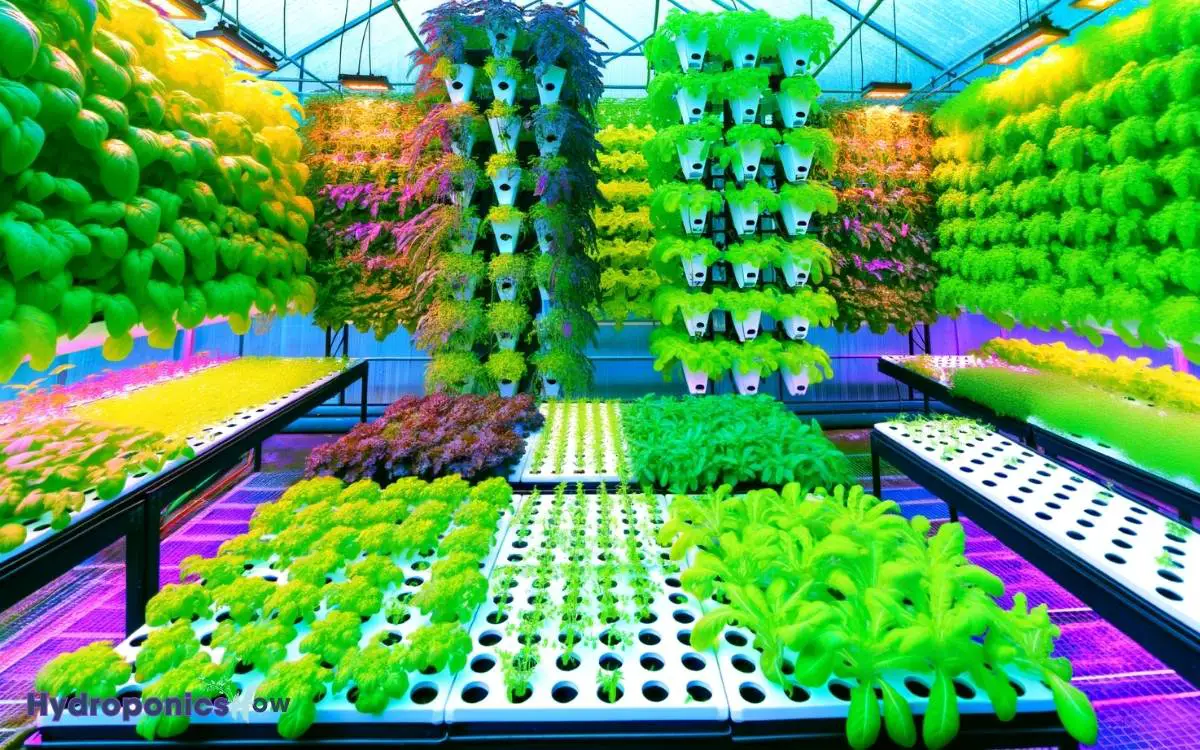
Key Takeaways
Deep Water Culture
Deep Water Culture (DWC) is a hydroponic system where plant roots are submerged directly in a nutrient-rich, oxygenated water solution, enabling ideal nutrient uptake and growth rates.
The effectiveness of DWC lies in its ability to maintain consistent dissolved oxygen levels, typically managed through air stones and air pumps.
Studies have demonstrated that DWC systems can achieve up to 20% faster growth rates compared to soil-based cultivation, attributed to the direct and unimpeded access to nutrients.
The pH and electrical conductivity (EC) of the solution are meticulously monitored, with preferred pH levels ranging between 5.5 and 6.5 and EC between 1.2 and 2.0 mS/cm.
This system is highly effective for leafy greens and herbs due to its simplicity and efficiency.
Nutrient Film Technique
The Nutrient Film Technique (NFT) is a hydroponic system where a thin film of nutrient-rich water continuously flows over the roots of plants, ensuring ideal nutrient delivery and oxygenation.
This technique is particularly advantageous for commercial growers due to its efficient use of resources and scalability.
Key aspects of NFT include:
- Root Exposure: Roots are continuously exposed to a nutrient solution, promoting peak growth rates and efficient nutrient uptake.
- Oxygenation: The thin film of water allows for excellent root oxygenation, preventing root diseases and enhancing plant health.
- Scalability: NFT systems can be easily scaled to accommodate various commercial operations, from small urban farms to large-scale agricultural enterprises.
These attributes contribute to the popularity and effectiveness of NFT in commercial hydroponic farming.
Ebb and Flow
Ebb and Flow, also known as Flood and Drain, is a hydroponic system where plants are periodically flooded with a nutrient solution and then allowed to drain, ensuring ideal nutrient delivery and aeration.
This system is advantageous due to its simplicity and efficiency in nutrient uptake.
| Parameter | Value |
|---|---|
| Flood Frequency | Typically 4-5 times/day |
| Pump Duration | 15-30 minutes per cycle |
| Medium Used | Rockwool, Hydroton |
| Nutrient Solution | Balanced N-P-K ratios |
| System Cost | Moderate |
Ebb and Flow systems excel in scalability and adaptability, making them suitable for various plant types.
The periodic flooding promotes oxygenation to the root zone, reducing the risk of root diseases and enhancing growth rates. Proper monitoring of the flood frequency and nutrient levels is essential for the plant health.
Aeroponics
Aeroponics utilizes a nutrient delivery method where a fine mist of nutrient solution is sprayed directly onto the plant roots, guaranteeing efficient nutrient uptake and water usage.
This system requires meticulous root health management to prevent pathogen proliferation and promote ideal oxygenation.
Data indicates that aeroponic systems can enhance growth rates by up to 60% compared to traditional soil-based cultivation.
Nutrient Delivery Methods
In aeroponic systems, nutrient delivery is achieved through the fine misting of nutrient-rich water directly onto the roots, ensuring effective absorption and ideal growth conditions.
This method offers several advantages:
- Increased Oxygenation: The roots are suspended in air, allowing for maximum oxygen exposure, which enhances nutrient uptake efficiency and promotes rapid growth.
- Water Conservation: Aeroponic systems use up to 90% less water compared to traditional soil-based methods, making them highly sustainable.
- Nutrient Precision: The exact concentration of nutrients can be meticulously controlled and adjusted, ensuring that plants receive the perfect balance for peak health.
These benefits make aeroponics a highly effective nutrient delivery method, particularly suited for commercial hydroponic applications aiming for high yield and resource efficiency.
Root Health Management
Effective root health management in aeroponic systems necessitates precise monitoring of root zone conditions, including humidity, temperature, and nutrient misting cycles.
Maintaining humidity levels between 70-80% ensures ideal root hydration while preventing fungal growth. Temperature control within the range of 18-24°C fosters ideal metabolic activity in root cells.
Nutrient misting cycles, typically set at intervals of 5-10 minutes, must be meticulously managed to deliver essential nutrients without causing root desiccation or oversaturation.
Advanced sensors and automated systems can facilitate real-time adjustments, enhancing root vitality and overall plant health. Regular inspection for root discoloration or pathogen presence is important for early intervention.
Adopting a data-driven approach ensures strong root systems, promoting vigorous plant growth in commercial aeroponic operations.
Drip Systems
Drip systems are characterized by precise nutrient delivery methods, where a controlled flow of nutrient solution is administered directly to the plant roots via emitters.
Effective system maintenance involves regular inspection and cleaning of emitters to prevent clogging, ensuring consistent nutrient distribution.
Data indicates that optimizing emitter flow rates and monitoring pH levels are critical for maximizing crop yield and health in commercial hydroponic operations.
Nutrient Delivery Methods
Utilizing precision-engineered emitters, drip systems deliver nutrients directly to the root zone, optimizing water and nutrient use efficiency in commercial hydroponic setups.
This method guarantees precise control over the nutrient solution, enhancing plant growth and yield.
Key benefits include:
- Targeted Nutrient Delivery: Drip systems facilitate the direct application of nutrients, minimizing waste and guaranteeing each plant receives the exact amount needed.
- Scalability: These systems can be easily scaled to accommodate various plant densities and sizes, making them ideal for both small and large-scale operations.
- Reduced Water Use: By delivering water directly to the roots, drip systems notably diminish water consumption, contributing to more sustainable agricultural practices.
System Maintenance Tips
Maintaining peak performance and longevity of drip systems in commercial hydroponics requires meticulous attention to maintenance protocols, including regular inspection and cleaning of emitters to prevent clogging.
Emitters must be checked weekly to identify blockages, which can have a substantial impact on nutrient delivery efficiency.
Utilizing a 10% bleach solution for monthly cleaning can eradicate biofilm buildup, thereby maintaining consistent flow rates.
Additionally, monitoring pH and electrical conductivity (EC) levels daily ensures ideal nutrient uptake, while periodic flushing of the system with clean water prevents salt accumulation.
Implementing a preventive maintenance schedule, including pump inspection and filter replacement every three months, can prevent system failures. Adhering to these practices guarantees the system’s operational integrity and maximizes crop yield.
Wick Systems
Wick systems are a passive hydroponic method that relies on capillary action to deliver nutrient solutions to plant roots.
This system is recognized for its simplicity and low maintenance, making it an ideal option for smaller-scale commercial operations. The core components include a reservoir, growing tray, and wicking material such as nylon wicks.
Key advantages include:
- Cost-effectiveness: Minimal initial investment and operational costs due to the absence of pumps and electrical components.
- Energy efficiency: Completely passive system that requires no electricity, reducing overall energy consumption.
- Scalability: Easily adaptable for different sizes of operations, from small-scale to moderately large commercial setups.
Wick systems, while less complex, require precise monitoring of nutrient levels and consistent wicking material upkeep to ensure the best plant growth.
Vertical Hydroponics
Vertical hydroponics systems maximize space utilization by stacking multiple growing layers, allowing for higher plant density and improved yield per square foot.
Utilizing vertical farming techniques increases the efficiency of light distribution and nutrient delivery across the plant canopy.
These systems frequently incorporate advanced technologies such as LED lighting, automated nutrient dosing, and climate control to maintain ideal growing conditions.
Data from commercial operations demonstrate that vertical hydroponics can achieve up to ten times the yield per unit area compared to traditional soil-based farming.
Methodically designed to reduce resource consumption, vertical systems can result in up to 90% less water usage. Consequently, vertical hydroponics presents an innovative solution for urban agriculture, addressing space constraints and enhancing production sustainability.
Aquaponics Integration
Aquaponics integration combines hydroponics with aquaculture, creating a symbiotic environment where fish waste supplies essential nutrients for plant growth while plants naturally filter and purify the water for the aquatic species.
This method optimizes resource utilization and minimizes waste through a closed-loop system.
Key considerations for commercial aquaponics include:
- System Design: Essential components include fish tanks, biofilters, hydroponic beds, and water circulation systems. Precision in design guarantees optimal nutrient transfer and water quality.
- Species Selection: Choosing compatible fish and plant species is important for maintaining a balanced ecosystem. Tilapia and leafy greens are commonly paired due to their complementary nutrient requirements.
- Water Quality Management: Continuous monitoring of pH, ammonia, nitrate levels, and dissolved oxygen ensures both fish and plant health, maximizing growth conditions.
Fogponics
Fogponics is a subset of aeroponics that uses a fine mist to deliver nutrient solutions directly to plant roots.
This method optimizes nutrient uptake and oxygenation, leading to benefits like enhanced growth rates and efficient resource utilization.
However, fogponics also poses challenges such as system maintenance and potential mist distribution issues.
A thorough examination of fogponics involves understanding its operational mechanics, evaluating its advantages, and addressing its inherent limitations.
How Fogponics Works
Utilizing ultrasonic technology, fogponics generates a nutrient-rich mist that envelops plant roots, facilitating efficient nutrient uptake and ideal growth conditions.
This method leverages piezoelectric transducers to convert electrical energy into high-frequency vibrations, which atomize the nutrient solution into fine droplets. The process guarantees ideal root oxygenation and nutrient absorption.
Key elements of fogponics include:
- Ultrasonic Transducers: These devices operate at frequencies typically between 1.7 to 2.5 MHz, producing droplets with diameters between 5 to 30 micrometers.
- Nutrient Solution Reservoir: A carefully calibrated mixture of water and essential nutrients, maintained within specific pH and electrical conductivity (EC) ranges.
- Distribution System: A network of tubing and nozzles that evenly disseminates the mist to plant root zones, ensuring uniform exposure.
This precision-driven approach enhances plant health and growth efficiency.
Benefits of Fogponics
The primary advantages of fogponics include superior nutrient delivery efficiency, ideal root aeration, and reduced water consumption compared to traditional hydroponic methods.
Utilizing ultrafine droplets, typically in the range of 1-50 micrometers, fogponics guarantees optimal nutrient absorption by maximizing the surface area in contact with plant roots. This leads to enhanced growth rates and higher yields.
The fine mist promotes excellent oxygenation, preventing root suffocation and encouraging robust root development. Additionally, fogponic systems are highly water-efficient, utilizing up to 90% less water than conventional soil-based cultivation.
This reduction in water usage is particularly advantageous in regions with limited water resources. Overall, fogponics represents a significant advancement in precision agriculture and sustainable horticultural practices.
Challenges of Fogponics
Despite its numerous advantages, fogponics presents several technical challenges that necessitate meticulous system design and maintenance. These challenges often impede peak performance and crop yield.
- Nozzle Clogging: The atomizing nozzles, essential for creating nutrient-rich fog, are prone to clogging due to particulate matter. Frequent cleaning and filtration systems are required, increasing labor and operational costs.
- Nutrient Delivery Consistency: Achieving consistent nutrient distribution can be difficult. Variations in fog density and droplet size can result in uneven nutrient uptake, potentially stunting plant growth.
- Humidity Control: Maintaining ideal humidity levels is critical. Excessive humidity can lead to pathogen proliferation, while insufficient levels may result in plant desiccation. Advanced monitoring and control systems are essential to mitigate these risks.
These factors demand ongoing attention to ensure system effectiveness.
Hybrid Systems
Hybrid hydroponic systems, which integrate multiple hydroponic techniques such as nutrient film technique (NFT) and deep water culture (DWC), offer customizable solutions optimized for various crop requirements.
This adaptability is achieved by leveraging the strengths of each method; for instance, NFT provides efficient nutrient delivery, while DWC guarantees consistent oxygenation to root zones.
Data shows these systems can increase yield by up to 30% compared to single-method setups. Key parameters, including pH, electrical conductivity (EC), and dissolved oxygen (DO) levels, are meticulously monitored and adjusted to optimize plant health.
Hybrid systems are particularly effective in commercial operations, where maximizing space utilization and resource efficiency are crucial. This approach ensures robust plant growth and enhanced overall productivity.
Conclusion
The intricate landscape of commercial hydroponic systems presents a mosaic of methodologies, each meticulously designed to optimize plant growth in controlled environments. These systems eliminate the need for soil by delivering nutrients directly to plant roots, enhancing efficiency and sustainability. Among the various types of hydroponic systems, techniques such as nutrient film technique (NFT), deep water culture (DWC), and aeroponics stand out for their ability to maximize space and resource utilization. By carefully selecting the appropriate system, growers can achieve higher yields while minimizing water and nutrient waste.
From the deep, nutrient-rich waters of Deep Water Culture to the delicate mist of Fogponics, these systems embody precision and innovation.
The harmonious blend of technology and nature in Aquaponics and the vertical elegance of Vertical Hydroponics illustrate the boundless potential of modern agriculture.
Such advancements promise a future where efficiency and sustainability flourish side by side.

